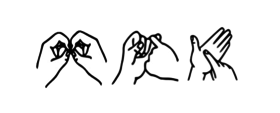British sign language
| British Sign Language (BSL) | |
|---|---|
| Native to | United Kingdom |
|
Native speakers
|
77,000 (2014) 250,000 L2 speakers (2013) |
|
BANZSL
|
|
| none widely accepted SignWriting |
|
| Official status | |
|
Official language in
|
Scotland |
|
Recognised minority
language in |
Wales, England, Scotland, Northern Ireland
|
| Language codes | |
| ISO 639-3 | |
| Glottolog | brit1235 |
British Sign Language (BSL) is a sign language spoken in the United Kingdom (UK), and is the first or preferred language of some deaf people in the UK; there are 125,000 deaf adults in the UK who use BSL plus an estimated 20,000 children. In 2011, 15,000 people, living in England and Wales, reported themselves using BSL as their main language. The language makes use of space and involves movement of the hands, body, face and head. Many thousands of people who are not deaf also use BSL, as hearing relatives of deaf people, sign language interpreters or as a result of other contact with the British Deaf community.
History exist of a sign language existing within deaf communities in England as far back as 1570. British Sign Language has evolved, as all languages do, from these origins by modification, invention and importation.Thomas Braidwood, an Edinburgh teacher, founded 'Braidwood's Academy for the Deaf and Dumb' in 1760 which is recognised as the first school for the deaf in Britain. His pupils were the sons of the well-to-do. His early use of a form of sign language, the combined system, was the first codification of what was to become British Sign Language. Joseph Watson was trained as a teacher of the Deaf under Thomas Braidwood and he eventually left in 1792 to become the headmaster of the first public school for the Deaf in Britain, the London Asylum for the Deaf and Dumb in Bermondsey.
In 1815, an American Protestant minister, Thomas Hopkins Gallaudet, travelled to Europe to research teaching of the deaf. He was rebuffed by both the Braidwood schools who refused to teach him their methods. Gallaudet then travelled to Paris and learned the educational methods of the French Royal Institution for the Deaf, a combination of Old French Sign Language and the signs developed by Abbé de l’Épée. As a consequence American Sign Language today has a 60% similarity to modern French Sign Language and is almost unintelligible to users of British Sign Language.
Until the 1940s sign language skills were passed on unofficially between deaf people often living in residential institutions. Signing was actively discouraged in schools by punishment and the emphasis in education was on forcing deaf children to learn to lip read and finger spell. From the 1970s there has been an increasing tolerance and instruction in BSL in schools. The language continues to evolve as older signs such as alms and pawnbroker have fallen out of use and new signs such as internet and laser have been coined. The evolution of the language and its changing level of acceptance means that older users tend to rely on finger spelling while younger ones make use of a wider range of signs.
...
Wikipedia

